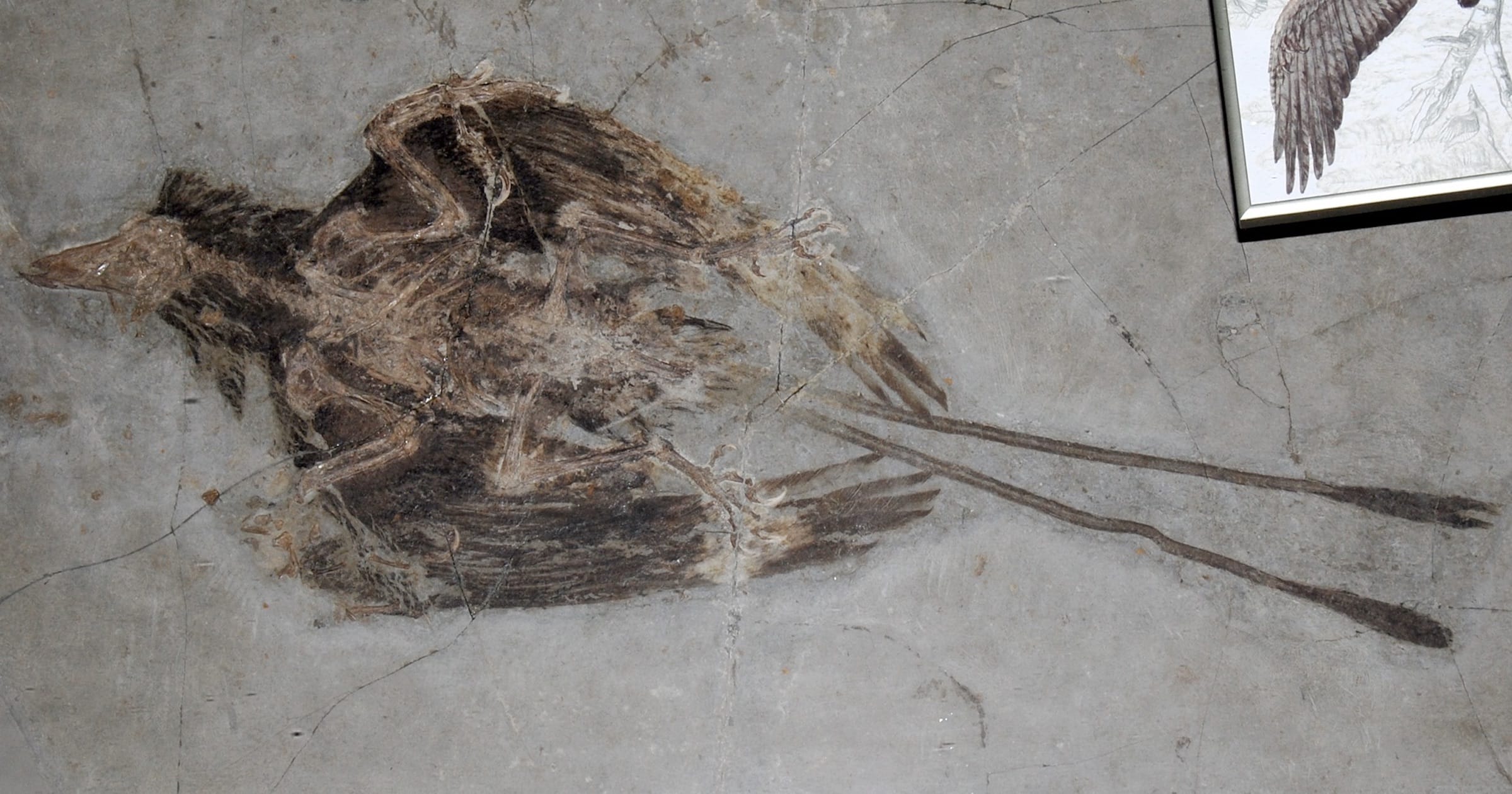 Evolution
Evolution
 Paleontology
Paleontology
Fossil Friday: A Popular Just-So Story on the Origin of Bird Flight Bites the Dust

This Fossil Friday features the early bird Confuciusornis from the Lower Cretaceous of Liaoning in China. Last week I reported for Fossil Friday on a just-so story about ichthyosaur evolution and how it fell apart (Bechly 2023). This week I want use the opportunity to report yet another case of a popular evolutionist just-so story that recently was put to rest for good. It is about the origin of avian flight.
An Old Debate About Birds
There is a long-running debate in evolutionary biology, asking whether birds took off by running and flapping from the ground up (cursorial hypothesis), or whether they jumped as gliders from the tree down (arboreal hypothesis). About twenty years ago there was a modification of the cursorial hypothesis suggested by Dial (2003), based on the observation in chicks of living Chukar partridge: it is the so-called wing-assisted incline running (WAIR) hypothesis, which suggested that wing flapping lifts the body during uphill running. This was also claimed to answer the old question “What use is half a wing?” (Dial et al. 2006), which obviously is not just an iconic question Darwin skeptics came up with.
The WAIR hypothesis quickly became more and more popular, with dozens of studies published on various aspects, such as aerodynamics (Tobalske & Dial 2007, Dial et al. 2008), mechanics (Bundle & Dial 2003), kinematics (Baier et al. 2013), and computer modelling (Heers et al. 2018). “According to the proponents of the WAIR hypothesis, adaptation to WAIR in avian ancestors prepared their locomotor apparatus for the subsequent evolution of forward flapping flight. In other words, WAIR is proposed as a preadaptation to full-fledged avian flapping flight.” (Kuznetsov & Panyutina 2022)
The Function of Wing Flapping
However, last year a new study by Kuznetsov & Panyutina (2022) showed that, contrary to earlier beliefs, the function of the wing flapping during uphill running is not to lift the body, but to push it towards a steep slope. This is the opposite adaptation to powered flight and requires very different muscles. Actually, “it follows that the action of the forelimb during WAIR cannot preadapt the musculature in a non-flying ancestor to free flapping flight. Furthermore, the wing action during WAIR [already] requires highly developed avian flight musculature.”
Therefore, the authors concluded that “Wing-assisted incline running should be regarded as a crown locomotor specialization of birds and is not an appropriate model for locomotion in avian ancestors.” Unsurprisingly, there was not a shred of paleontological evidence for the WAIR hypothesis (Nudds & Dyke 2009), and non-avian feathered dinosaurs as well as early birds arguably were incapable of WAIR (Senter 2006), which is the opposite of the model’s prediction. It looks like yet another evolutionist just-so story bites the dust after empirical data failed to support the imaginative storytelling.
References
- Baier DB, Gatesy SM & Dial KP 2013. Three-dimensional, high-resolution skeletal kinematics of the avian wing and shoulder during ascending flapping flight and uphill flap- running. PLoS One 8(5): e63982, 1–16. DOI: https://doi.org/10.1371/journal.pone.0063982
- Bechly G 2023. Fossil Friday: Ichthyosaur Birth, Another Evolutionist Just-So Story Falls Apart. Evolution News September 29, 2003. https://evolutionnews.org/2023/09/fossil-friday-ichthyosaur-birth-another-evolutionist-just-so-story-falls-apart/
- Bundle MW & Dial KP 2003. Mechanics of wing-assisted incline running (WAIR). Journal of Experimental Biology 206(24), 4553–4564. DOI: https://doi.org/10.1242/jeb.00673
- Kuznetsov AN & Panyutina AA 2022. Where was WAIR in avian flight evolution? Biological Journal of the Linnean Society 137(1), 145–156. DOI: https://doi.org/10.1093/biolinnean/blac019
- Dial KP 2003. Wing-Assisted Incline Running and the Evolution of Flight. Science 299(5605), 402–404. DOI: https://doi.org/10.1126/science.1078237
- Dial KP, Randall RJ & Dial TR 2006. What use is half a wing in the ecology and evolution of birds? BioScience 56(5), 437–445. DOI: https://doi.org/10.1641/0006-3568(2006)056[0437:WUIHAW]2.0.CO;2
- Dial KP, Jackson BE & Segre P 2008. A fundamental avian wing-stroke provides a new perspective on the evolution of flight. Nature 451(7181), 985–989. DOI: https://doi.org/10.1038/nature06517
- Heers AM, Rankin JW & Hutchinson JR 2018. Building a Bird: Musculoskeletal Modeling and Simulation of Wing-Assisted Incline Running During Avian Ontogeny. Frontiers in Bioengineering and Biotechnology 6: 140, 1–25. DOI: https://doi.org/10.3389/fbioe.2018.00140
- Nudds RL & Dyke GJ 2009. Forelimb posture in dinosaurs and the evolution of the avian flapping flight-stroke. Evolution 63(4), 994–1002. DOI: https://doi.org/10.1111/j.1558-5646.2009.00613.x
- Senter P 2006. Scapular orientation in theropods and basal birds, and the origin of flapping flight. Acta Palaeontologica Polonica 51(2), 305–313. https://www.app.pan.pl/article/item/app51-305.html
- Tobalske BW & Dial KP 2007. Aerodynamics of wing-assisted incline running in birds. The Journal of Experimental Biology 210(10), 1742–1751. DOI: https://doi.org/10.1242/jeb.001701
